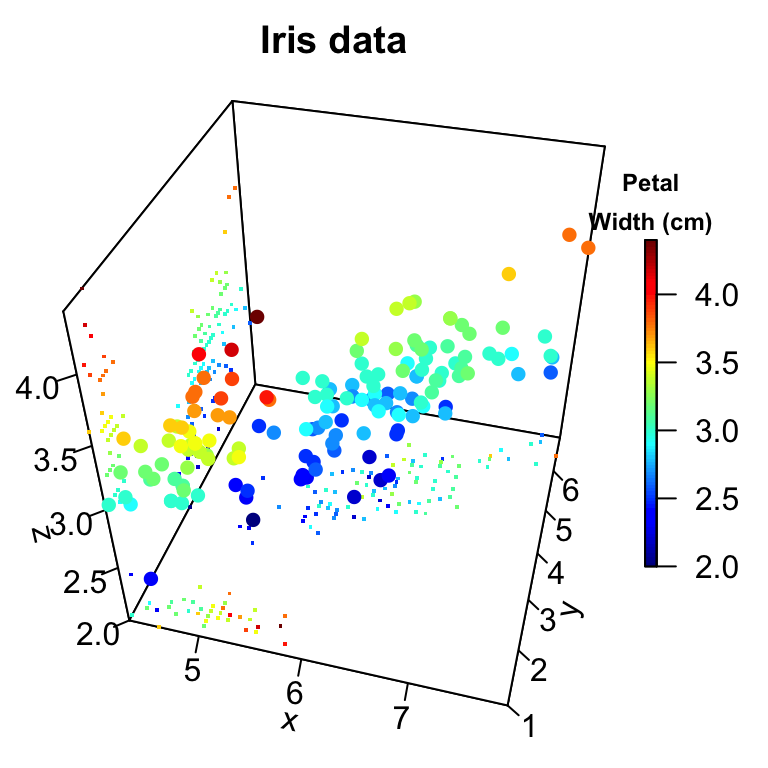

This useful package will automatically adjust labels so that they don’t overlap. Instead, we can try the ggrepel package by Kamil Slowikowski. There are some additional arguments that can go into geom_label() that allow for label offset however, this won’t help us much here. The labels are helpful but just too cluttered. Ggplot( data = crime, aes( x = burglary, y = motor_vehicle_theft, size=population / 100000)) + geom_point( color = "blue") + geom_label( aes( label = state), alpha = 0.5) + scale_x_continuous( name= "Burglaries per 100,000 population", limits= c( 0, max(crime $burglary))) + scale_y_continuous( name= "Motor vehicle theft per 100,000 population", limits = c( 0, max(crime $motor_vehicle_theft))) + labs( size= "Population \n (100,000)")
Scatter plot in r studio code#
In addition to the free on-line version available through MSU, the book’s source code is available at. The book goes into much more depth on the theory underlying the grammar and syntax, and has many examples on solving practical graphical problems. It is available on-line in digital format from MSU’s library. Once you work through this chapter, the best place to learn more about ggplot2 is from the package’s official book Wickham and Sievert ( 2016) by Hadley Wickham. As will become obvious, once this grammar is mastered for a particular type of plot, such as a scatter plot, it is easy to transfer this knowledge to other types of graphics. The grammar describes the mapping from data to the graphical display’s aesthetic attributes (color, shape, size) of geometric objects (points, lines, bars). The package provides a unified and logical way to describe graphical displays such as scatter plots, histograms, bar charts, and many other types of graphics. The gg in ggplot2 stands for Grammar of Graphics. We simply want to present you with both sets of tools so that in the future when you have graphs to produce you can use whichever package floats your boat! For now we’ll start off with ggplot2 and get to graphics in Chapter 15. You’ll notice that the chapters are essentially the same, producing the same graphs (with a few exceptions) to let you decide which graphing style you prefer. We use ggplot2 throughout the text, and thus require you to read this chapter on ggplot2 while Chapter 15 on the graphics package is optional.
Scatter plot in r studio how to#
Knowing how to use both the graphics and ggplot2 packages is worthwhile, so we denote one chapter to ggplot2 and a second chapter to graphics. However, the graphics package seemingly provides more control over different graphical parameters, and can sometimes be more intuitive than ggplot2.

25 For beginners ggplot2 has somewhat simpler syntax, and also produces excellent graphics without much tinkering. The two leading packages are the graphics package, which comes with your base installation of R, and the ggplot2 package, which must be installed and made available by the user. There are several packages available in R for creating graphics. Creating “standard” graphical displays is straightforward, but a main strength of R is the ability to customize graphical displays to create either non-standard graphics or to modify more standard graphical displays to create publication-ready versions. R can be used to create a vast array of graphical representations of data. 15.6 A Summary of Useful graphics Functions and Arguments.14.3 Fourier Transforms and Spectrograms.14.1 Introduction to Digital Signal Processing.13.2 Difficulties of Working with Large Datasets.9.4.2 Michigan Campgrounds Server Logic.9.4 More Advanced Shiny App: Michigan Campgrounds.8.7.2 Logical, Index, and Name Subsetting.8.7.1 Fetching and Cropping Data using raster.8 Spatial Data Visualization and Analysis.7.2 Programming: Conditional Statements.6.2 Reading Data with Missing Observations.4.7.2 Logical Subsetting and Data Frames.4.7.1 Modifying or Creating Objects via Subsetting.4.6.1 Accessing Specific Elements of Lists.4.5.1 Accessing Specific Elements of Data Frames.4.1.2 Accessing Specific Elements of Vectors.3.2.1 Creating and processing R Markdown documents.2.5 Workspace, Working Directory, and Keeping Organized.2.3.3 Basic descriptive statistics and graphics in R.1.6 How to learn (The most important section in this book!).


 0 kommentar(er)
0 kommentar(er)
